Walking round London pt26: Isleworth to Hanwell Locks
Away from the Thames and up a canal — or is it a river? Or is it both?
(ICYMI: Having executed a 120km circumnavigation of the capital for charity, the writer has produced these blogs to publicise the fundraising and consider the vernacular. There’s a full list of chapter/sections at the end of each blog.)
Syon Park has been the domain of various Dukes of Northumberland since 1594, but they aren’t the first to play house here: it’s been settled, off and on, since the Iron Age. What the Dukes have done to make their mark is foist an erection upon Mother Nature.
Picking our way between a sign on the left saying “Private: No Access” and one on the right warning “Private: Warning! Guards Dogs Running Free,” we follow the proscribed path. Away to the left, the Art Deco tower of the Gilette building pops above the trees, the only evidence visible from here of the Great West Road’s Golden Mile of 1930s architecture. I dare say I’ll cover that mile for these pages at some point.

First, though, we must pass Syon House, built 1552 and much faffed about with since. It’s predictably grade-I listed but to me it looks dull and try-hard. Various worthies have got their hands dirty here — designer Robert Adam, architect Inigo Jones, landscape legend Capability Brown — but it feels designed by committee, ending in a tasteless buffet recalling Oscar Wilde’s line about knowing the price of everything and the value of nothing.

To my eye, reduced to straining from afar while standing under the leonine statues which seem de rigueur among those with more money than style, the rooftop crenellations thematically jar with the Georgian windows, which present themselves with their usual metronomic regularity: often a pleasure, but here bordering on soulless sterility.
This is architecture as costume party: not in the way which, round the corner, All Saints throws together its various styles with childlike glee, but with the bored detachment of the idle rich for whom nothing ever brings contentment. It’s presumably grade I-listed for its constituent parts rather than its unconvincing whole — a mishmash of architectural styles, porticoes, crenellations, columns holding up porticoes.
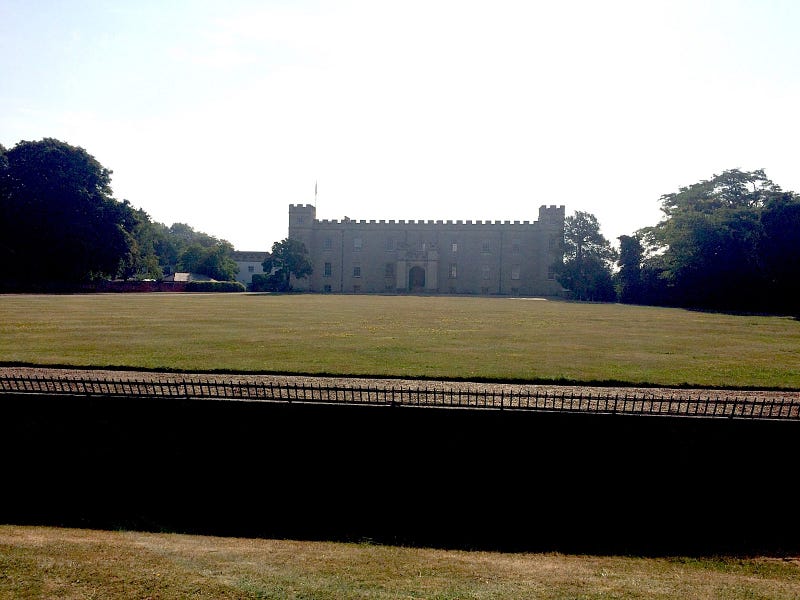
In 2007, obviously short of a bob or two, the incumbents sold off the popular Butterfly House for a hotel. Some of the butterflies moved to a new place in Lincolnshire, which shut down five years later, just a year after the opening of the five-star Hilton Worldwide Waldorf Astoria-owned hotel which one reviewer described as “a hideous brick sprawl that reminds me of the original Crossroads TV motel or those out-of-town Tescos that are meant to be cutting-edge”. The lobby has a display of butterflies. You can’t make this stuff up.
On with quickened pace through the busy Brentford streets to its canal basin, extensively reworked in the post-industrial era with the usual array of opportunist apartment blocks. The Juliet balconies gaze down upon a waterway that is pleasingly busy with barges, themselves lovingly restored for a new usage as pleasure rather than business — although you can probably pay well to borrow one.

Credit here should be given to the various trusts who bring such places back to life. When one of London’s smallest museums, based in the grade II-listed listed Toll House, faced closure-threatening cuts, volunteers from the Canal & River Trust stepped up to keep it open, albeit for restricted hours. The same organisation also places signs not just for dog walkers but their canine companions.
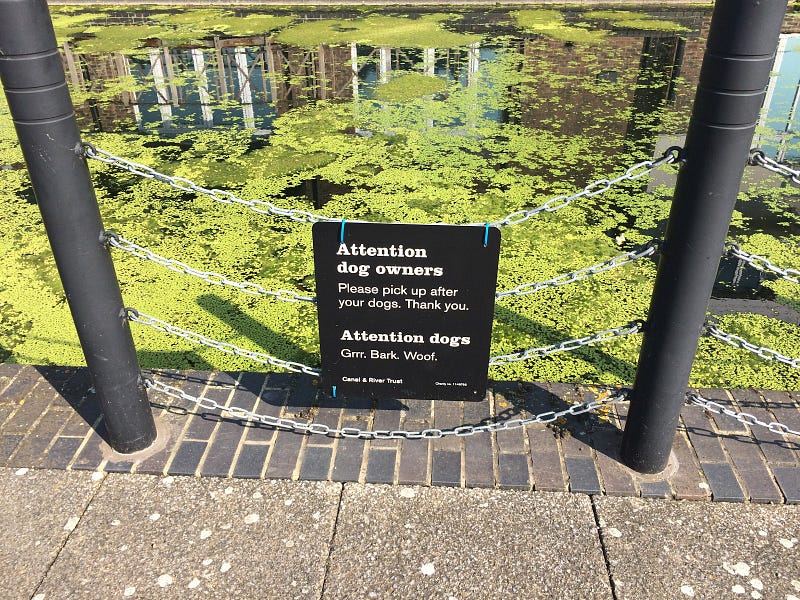
We leave the basin and walk up the River Brent, here canalised and navigable. At 16 miles the Brent is one of London’s longest rivers, starting up in Hendon at the junction of Dollis Brook and Mutton Brook; pleasingly, we had walked past that very confluence many miles ago on the first section of this entire Capital Ring thing. Downstream, it divided the districts of Willesden and Wembley until 1965, when the two were combined to form the borough of Brent.
The river’s name comes from Celtic words meaning ‘sacred waters’; the fording that gave Brentford its moniker was carried out by those busy old Romans. And the river inspired dear old John Betjeman into a typically trochaic verse which seems fitting for the day:
Gentle Brent, I used to know you
Wandering Wembley-wards at will,
Now what change your waters show you
In the meadowlands you fill!
Recollect the elm-trees misty
And the footpaths climbing twisty
Under cedar-shaded palings,
Low laburnum-leaned-on railings
Out of Northolt on and upward
To the heights of Harrow Hill.
Indeed I will end this walk by “Wandering Wembley-wards at will” — up “footpaths climbing twisty” via “the heights of Harrow Hill” — to where I started the first, at the Brent reservoir, although Betjeman would doubtless have called that by its more popular name of the Welsh Harp.
Just before the basin is fed by the Brent, there’s an overhanging warehouse whose bones have been left in situ but partially masked with a wood edifice. Too expensive, or too interesting, to trash?

Either way it serves as an interesting counterpoint to the estate-agent new-builds, and foretells further such evidence farther upstream. Reduced to a crawl slow enough to encourage algae, the waterway winds its way up under the Great West Road, past the glassy gaze of GSK and the green glades of Boston Manor Park and the London Playing Fields.
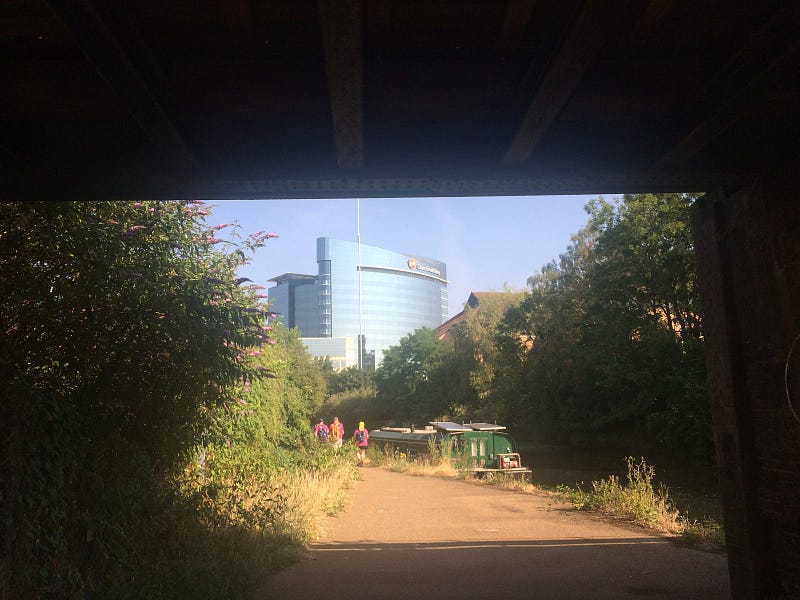
They’re all on the east bank, but our west bank is grittier: various works, earthpiles, aggregates, sand, “waste transfer stations” and the sort of light-industrial workplaces now marginalised to these strips, between railway and waterway, where accommodation is not yet lucrative enough to force out these services for a “regeneration”.
As if a social climber, the trail switches sides via an attractive single-spin iron footbridge with yellow-brick abutments. Described by one source with tantalising uncertainty as “probably designed by Thomas Telford”, it was definitely built in 1820, a sign upon it proudly ascribing it to the “Horseley Ironworks near Birmingham”.
This is the same foundry used in 1908 to rebuild the Richmond Railway Bridge encountered earlier on this walk; by that time the canal and rail networks they’d helped to create had shrunk the country, increasing its business potential and public awareness to the point where the railway bridge’s boilerplate could describe Horseley’s as being based in “London & Tipton”. Horseley’s closed in 1991, five years after this bridge was renovated by Marsh Bros.

The bridge’s rough surface gave better grip to the barge-pulling horses who would cross over it, back when this towpath was for business rather than pleasure. As a roving bridge, it’s cleverly designed so that the shires could pass under the bridge as well as crossing the canal, meaning they needn’t be time-consumingly unhitched.
It’s known locally as Gallows Bridge, which may come from a man found hanged in nearby Boston Manor woods in or around the 17th Century. As it is in most places, death is a repeating theme here: in March 2016 a 44-year-old artist was found on the towpath having perished from hypothermia.
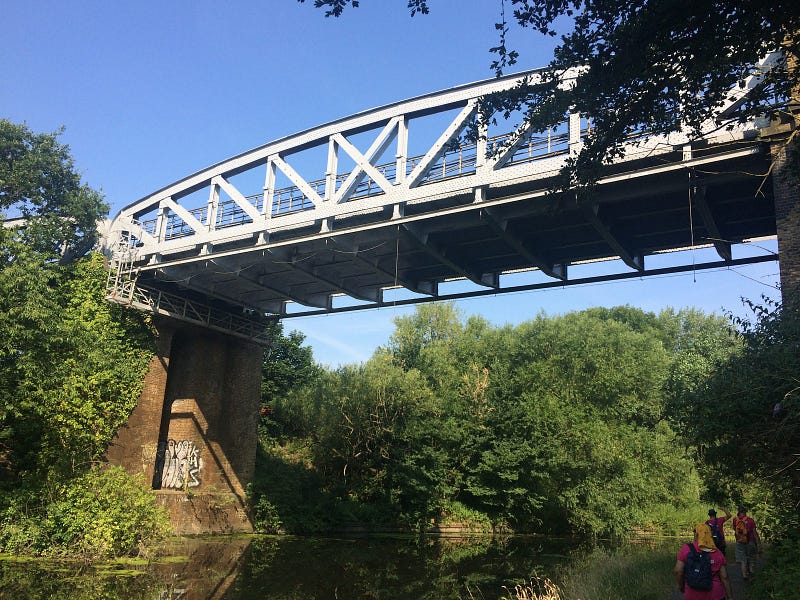
Two hundred metres upstream is the Wyke Green Railway Bridge, originally built in 1883 by the Hounslow & Metropolitan Railway to serve Hounslow Barracks — now Hounslow West; the line is now the Piccadilly.
The attractive lattice girder bridger is double-span, which allows for attractive spaces between the piers. This design foreshadows that of a much larger bridge not far ahead on the journey.
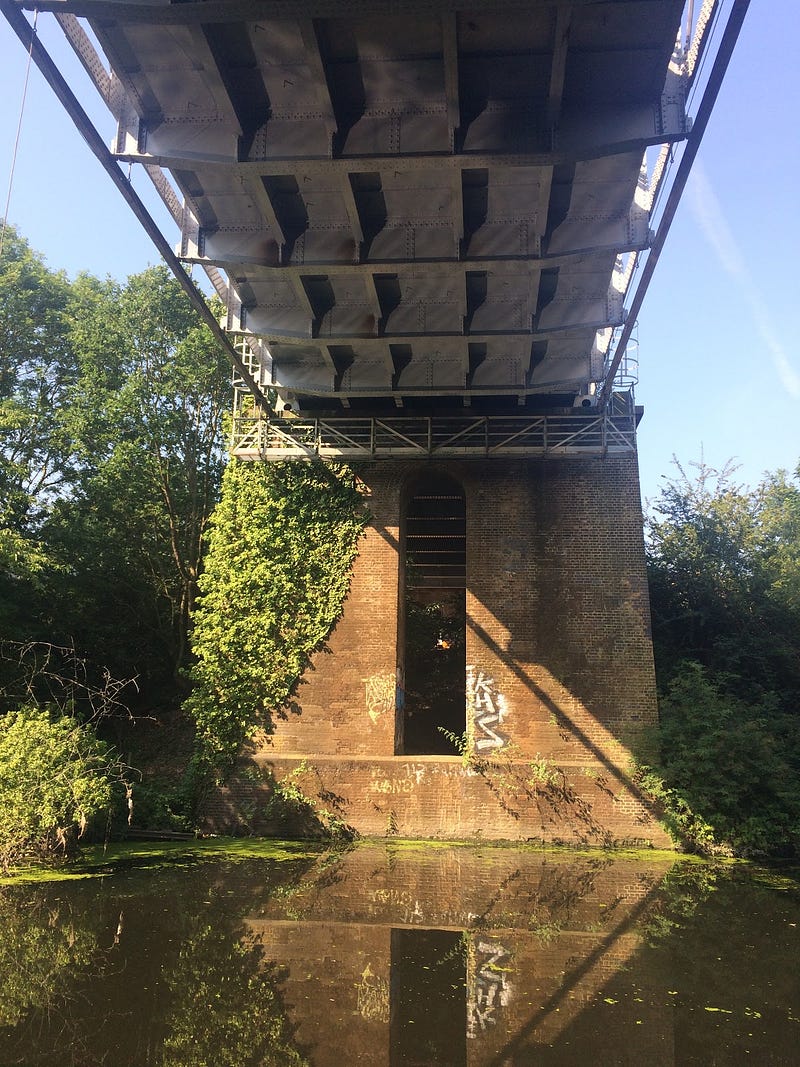
The Tube line lofts airily above the canal and path, but there is a somehow more tangible transport presence at hand. Somewhere to the right of the path is the swish and rumble of the M4, audible but not yet visible as it turns coquettishly northwards to avoid ploughing into the Sky broadcasting village; it will soon cross just above our heads, having swooped down off the achingly 1960s white-heat-of-technology Chiswick Flyover.
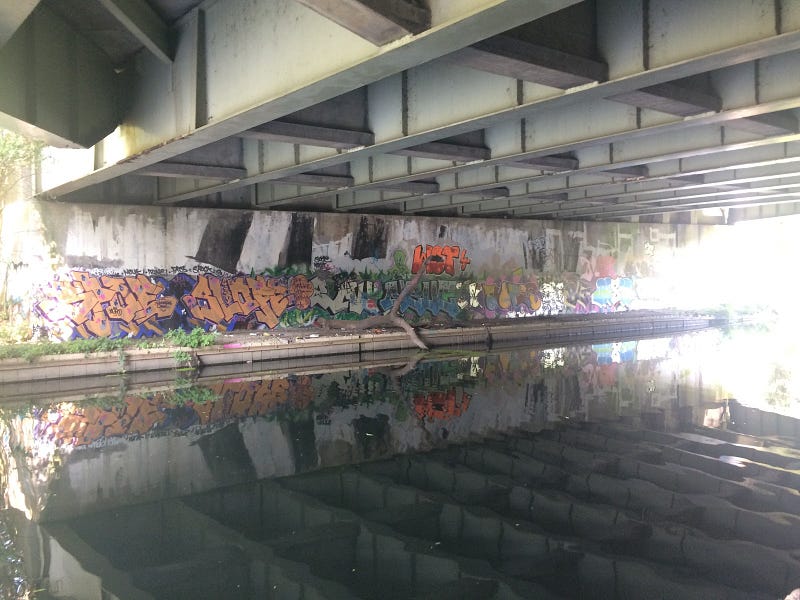
The latter flyover now winds between the glass towers of GSK and the University of West London, as society grows towards the skies via two of its greatest money-makers: medicine and academia. Just seconds away, it’s all ducks, swans and greenery: a different life along what used to be a similar type of traffic-choked arterial route to the capital.
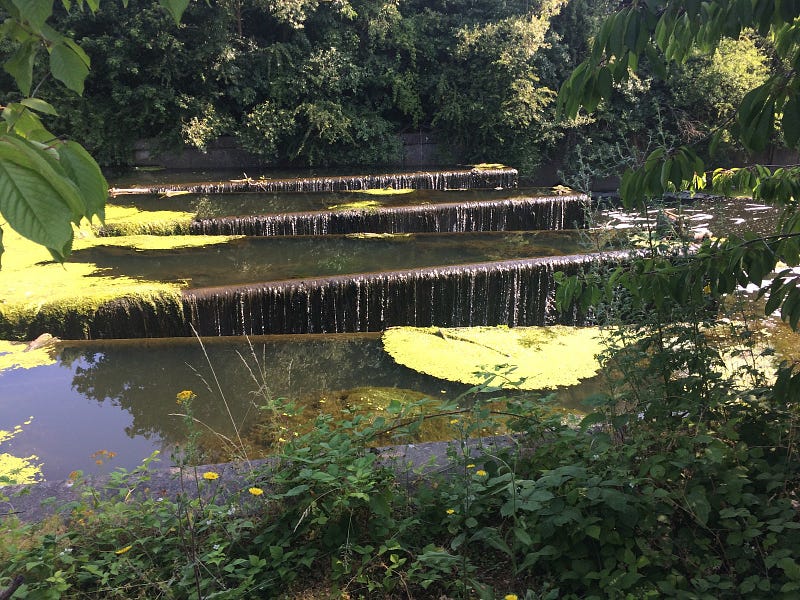
For the Grand Union Canal is the UK’s longest, 280-odd miles stretching from London to Birmingham that’ll take you just the 74 hours by boat. For its southernmost three miles to the Thames at Brentford, the canal and river are one and the same, with the Brent occasionally wandering shallowly off from the main canalised stretch.
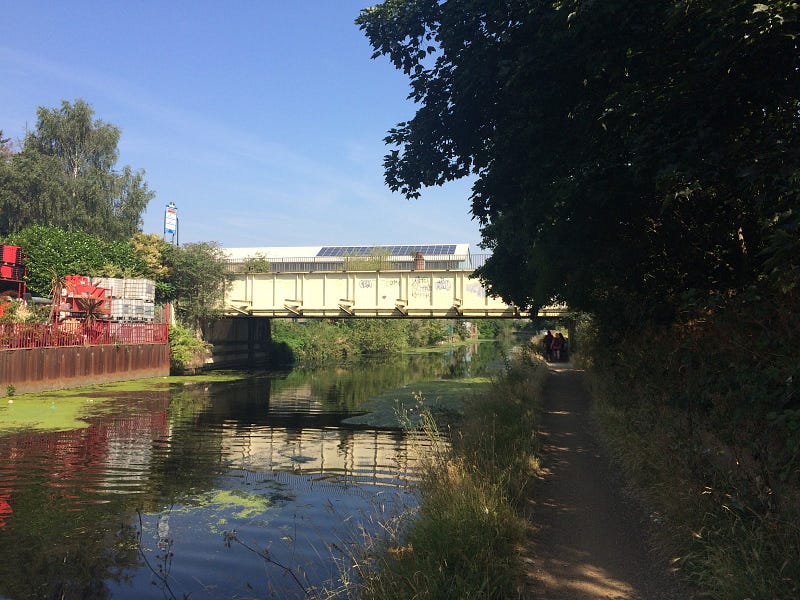
And wandering off is just what we do, although not until after passing under the rather ugly Trumpers Way Bridge — named after a local landowner who objected to the railways — and past an intriguing sign commemorating the Kerr Cup Pile Driving Competition.

Speaking of wandering off, that’s what we do now as we reach the first of three checkpoints, this one marking the end of the walk’s opening quarter. The checkpoint is 8.4km into today’s 30k, and we reach it at 9.45am. That’s bang on target for getting through the walk in seven hours — 1hr 45m between checkpoints — and even a little ahead, considering we set off after 8am.
It’s at a lovely little pub called The Fox, festooned with mirrors and flowers and wood, and attended by the usual lovely collection of Mencap helpers giving us water, food and encouragement — but we don’t tarry, we’re back on our toes again to hit the next deadline…
Next: Up the valley toward the Western Avenue
The Mencap Capital Challenge is a charity walk circling London in four quarters, each roughly 30km. You can donate or sponsor the writer at justgiving.com/garyparkinson1974.
NORTHERN QUARTER, SAT 5 MAY 2018
• Pt1: Wembley to East Finchley • Pt2: …to Finsbury Park
• Pt3: …to Clissold Park • Pt4: …to Springfield Park
• Pt5: …to Hackney Wick • Pt6: …to Bow Back River
• Pt7: …to Channelsea River • Pt8: …to Royal Victoria Dock
EASTERN QUARTER, SAT 26 MAY 2018
• Pt9: Victoria Dock to North Woolwich Pier • Pt10: …to Maryon Park
• Pt11: …to Hornfair Park • Pt12: …to Oxleas Wood
• Pt13: …to Eltham Palace • Pt14: …to Grove Park
• Pt15: …to Beckenham Place Park • Pt16: …to Penge
• Pt17: …to Crystal Palace Park • Pt18: …to Upper Norwood
SOUTHERN QUARTER, SAT 9 JUN 2018
• Pt19: Crystal Palace to Beulah Hill • Pt20: …to Streatham Common
• Pt21: …to Tooting Bec • Pt22: …to Wandsworth Common
• Pt23: …to Wimbledon Park • Pt24: …to Richmond Bridge
WESTERN QUARTER, SAT 7 JUL 2018
• Pt25: Richmond Bridge to Isleworth • Pt26: …to Hanwell Locks
• Pt27: …to Horsenden Hill • Pt28: …to Sudbury Hill
• Pt29: …to Wembley, and that's that




